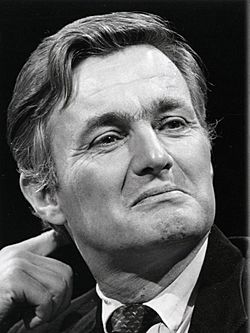Piet Dankert facts for kids
Quick facts for kids
Piet Dankert
|
|
|---|---|

Dankert in 1963
|
|
| State Secretary for Foreign Affairs | |
| In office 7 November 1989 – 16 July 1994 |
|
| Prime Minister | Ruud Lubbers |
| Preceded by | Berend-Jan van Voorst tot Voorst |
| Succeeded by | Michiel Patijn |
| President of the European Parliament | |
| In office 19 January 1982 – 24 July 1984 |
|
| Preceded by | Simone Veil |
| Succeeded by | Pierre Pflimlin |
| Member of the European Parliament | |
| In office 19 July 1994 – 20 July 1999 |
|
| In office 17 July 1979 – 7 November 1989 |
|
| Parliamentary group | Group of the Party of European Socialists (1994–1999) Socialist Group (1979–1989) |
| Constituency | Netherlands |
| Member of the House of Representatives | |
| In office 6 February 1968 – 10 June 1981 |
|
| Parliamentary group | Labour Party |
| Personal details | |
| Born |
Pieter Dankert
8 January 1934 Stiens, Netherlands |
| Died | 21 June 2003 (aged 69) Perpignan, France |
| Political party | Labour Party (from 1957) |
| Alma mater | University of Amsterdam (Bachelor of Education) |
| Occupation | Politician · Civil servant · Teacher · Lobbyist |
Pieter "Piet" Dankert (born January 8, 1934 – died June 21, 2003) was a Dutch politician. He was a member of the Labour Party (PvdA).
Piet Dankert was an important figure in Dutch and European politics. He held several key roles during his career. He worked as a teacher and researcher before becoming a politician.
Contents
Piet Dankert's Early Life and Career
Piet Dankert was born in Stiens, a town in the Netherlands. He went to the University of Amsterdam in 1951. There, he studied Education and earned his bachelor's degree in 1953.
After finishing his studies, Dankert worked as a civics teacher. He taught at a school in Gorinchem from 1960 to 1963. Later, he became a researcher and director at the Koos Vorrink Institute. This institute was connected to the Labour Party. He also served on the Labour Party's main board.
A Career in Politics
Piet Dankert started his political journey in the Dutch House of Representatives. He became a member in 1968. In this role, he spoke for his party on topics like foreign affairs and defense. He also focused on European matters.
In 1979, Dankert was elected as a Member of the European Parliament. This meant he worked in both the Dutch Parliament and the European Parliament at the same time. He chose to focus on his work in Europe from 1981 onwards.
Leading the European Parliament
One of Dankert's most important roles was serving as the President of the European Parliament. He held this position from January 1982 to July 1984. As President, he helped lead the European Parliament, which is the law-making body of the European Union.
After his time as President, Dankert continued to be involved in European affairs. He even taught about European integration at the University of Amsterdam for a period.
State Secretary and Return to Europe
In 1989, Piet Dankert became the State Secretary for Foreign Affairs in the Dutch government. He worked in this role until 1994. As State Secretary, he helped manage the Netherlands' relationships with other countries.
In 1994, Dankert decided to return to the European Parliament. He was elected again and served as a Member of the European Parliament until 1999. During this time, he worked hard on the idea of Turkey joining the European Union.
Honors and Awards
Piet Dankert received several special honors for his work. These awards recognized his important contributions to the Netherlands and Europe.
- He was made a Knight of the Order of the Netherlands Lion in 1980. This is a very high honor in the Netherlands.
- He also became a Grand Officer of the Order of Orange-Nassau in 1994. This is another important Dutch award.
- In 1996, he received the title of Grand Officer of the Order of Leopold II from Belgium.
See also
 In Spanish: Piet Dankert para niños
In Spanish: Piet Dankert para niños

